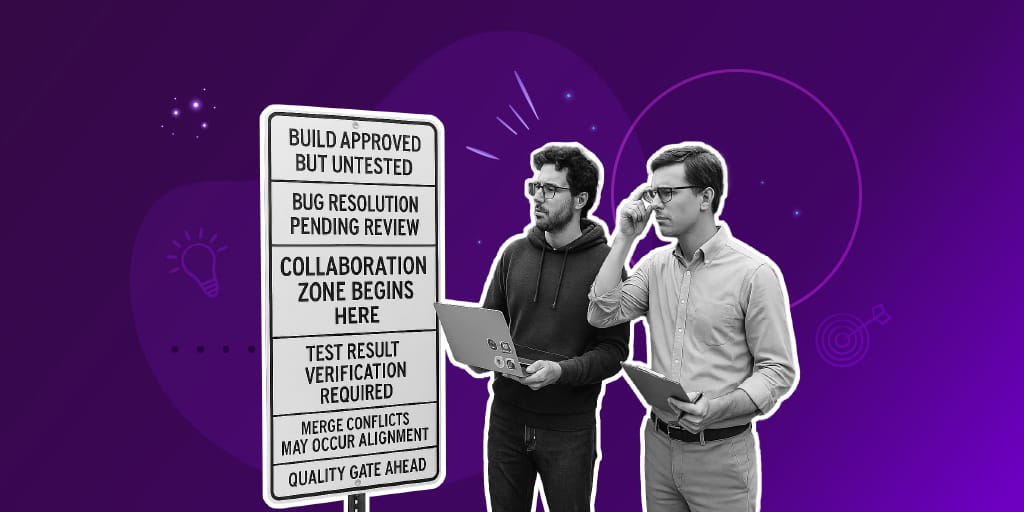Quick Overview
Strong collaboration between Dev and QA teams depends on shared understanding, early involvement, and consistent communication, not just process. When both sides stay aligned on goals and have visibility into what’s being built and tested, it becomes easier to prevent issues, catch risks early, and deliver reliable software together
When Ops and Product Had Two Different Realities
I was the release manager when, in my previous organization, we migrated our operations platform from a legacy monolith to a new microservices setup a year ago. Everything looked fine in staging, and we’d received sign-offs from Product and QA. But within an hour of going live, Slack lit up.
The ops team couldn’t use the system the way they were used to. It turned out our old monolith had a series of invisible workarounds that ops relied on daily. These weren’t in the new system, and no one had captured them in the requirements.
We realized that the QA team had tested what was documented, but no one had spoken to the end users about how they worked. And devs hadn’t known those behaviors existed.
Some requirements slipped through the cracks between Dev and QA, and a bug went live.
It wasn’t due to a lack of testing; QA had covered everything that was documented. The real issue was that no one had captured how the ops team actually used the system day to day. Those details lived in habits, not in specs. And because Dev, QA, and Product weren’t consistently aligned, those habits never came up.
That release taught us something important: collaboration doesn’t just happen during planning or handoffs. It has to be continuous, even if it’s lightweight.
The practical insights I’ll share in this article come from a few changes we made to close those gaps. They’re simple habits that helped us stay better connected, without adding overhead, and they’re easy to apply in your organization too.
What Gets in the Way of Dev and QA Collaboration?
When developers and QA testers work in silos, often bugs slip through, timelines stretch, and the blame game begins. Better collaboration between Dev and QA doesn’t mean adding more meetings. It’s about building a shared understanding, trust, and repeatable systems that make quality a joint responsibility.
While better alignment between Dev and QA is possible, it doesn’t happen just because everyone wants the same outcome. Several things tend to get in the way, some obvious, others more subtle.
For starters, developers and QA often work with different priorities. Developers focus on delivering features quickly; QA focuses on stability and risk. When those goals aren’t openly discussed, tension builds, especially when deadlines get tight.
QA is also often brought in too late, once development is already underway or nearly finished. At that point, they’re testing against moving targets or incomplete specs, which makes it harder to ask the right questions or catch edge cases early.
Even when requirements exist, teams don’t always share the same understanding of what needs to be built or how it will be used. Developers might assume something is clear. QA might rely on outdated test cases. And unless someone connects the dots, key details get missed.
There’s also the issue of scattered communication. When updates live across tickets, Slack threads, and hallway conversations, things fall through the cracks. And if teams aren’t working from a shared source of truth, collaboration turns into guesswork.
Lastly, in some teams, it’s hard to speak up. If people worry they’ll be blamed for missing something, they tend to stay quiet. That lack of psychological safety slows down real collaboration, even when the intent is there.
None of these issues is unsolvable. But they do show why collaboration needs to be intentional. In the next section, I’ll share a few practices that helped our teams stay connected, catch blind spots earlier, and build better releases together.
The Role of the Release Manager in Dev and QA Collaboration
Dev and QA don’t need to speak the same language, but they do need to share the same goals.
You can rely on your usual super dependable release manager 😉 . Release managers are in a unique position to connect the dots across Dev, QA, Product, and even Ops. While developers and testers may focus on their immediate tasks, the Release Manager can help ensure that everyone is aligned on the shared goal, delivering reliable, working software to users.
That means:
Facilitating early alignment on what success looks like
Creating a central checklist or release dashboard that everyone can reference
Reinforcing the importance of shared responsibility over individual handoffs
When a release manager drives these habits, it becomes easier for Dev and QA teams to stay focused on the same outcome rather than just their respective deliverables.
In case you do not have a release manager, check this post where I talk in detail about when and when not to hire a release manager.
How to Improve Collaboration Between Development and QA Teams?
Improving collaboration between Dev and QA starts with shifting the mindset from handoffs to shared ownership. It means bringing QA into conversations early, not just when the code is ready to test. When both teams have access to the same information, understand the same goals, and work with consistent environments, it becomes easier to catch issues before they escalate. Collaboration grows when there’s space for feedback, mutual respect for expertise, and a clear understanding of who owns what, so that Dev and QA can work in sync, not in sequence.
In the sections that follow, you’ll find practical examples and step-by-step actions to help make that kind of collaboration part of your day-to-day work.
Building Quality Together, Not in Isolation
Here is another example: a few years ago, while working with a banking client, we decided to build an automated test suite to validate the online banking portal regularly. It was a twist on test-driven development. QA created automation scripts to validate ongoing development work.
These automation suites are never easy to maintain. But this time, Dev and QA sat down together right from the start. They agreed on identifiers, reusable components, and other technical conventions that would make the suite more robust. Developers are committed to flagging any changes that might impact automation early, giving QA time to adjust.
The process became beautifully asynchronous. QA would push test suite updates by the end of the day. When developers deployed new changes, the automation suite was already primed to validate them.
Sure, some bugs still slipped through. But because both Dev and QA shared responsibility for the environment and the application, fixes were faster. QA updated the suite, Dev resolved the issue, and we could validate everything before the next production deployment.
That kind of responsiveness doesn’t just reduce risk, it builds confidence in the team.
Conclusion
Dev–QA collaboration improves when teams stay connected throughout the process, not just at the start or the end. What makes the biggest difference isn’t more process, it’s clarity, consistency, and shared understanding. When teams work with transparency and mutual respect, quality becomes something everyone contributes to, not something owned by one role alone.
To wrap up, here are the key points to remember when building stronger Dev–QA collaboration.
Key Takeaways
- Involve QA from the start of planning and grooming
- Use shared tooling to reduce silos and increase visibility
- Align environments early to avoid conflicts and flaky bugs
- Build empathy between Dev and QA through shared ownership
- Automate feedback loops using CI/CD integrations

